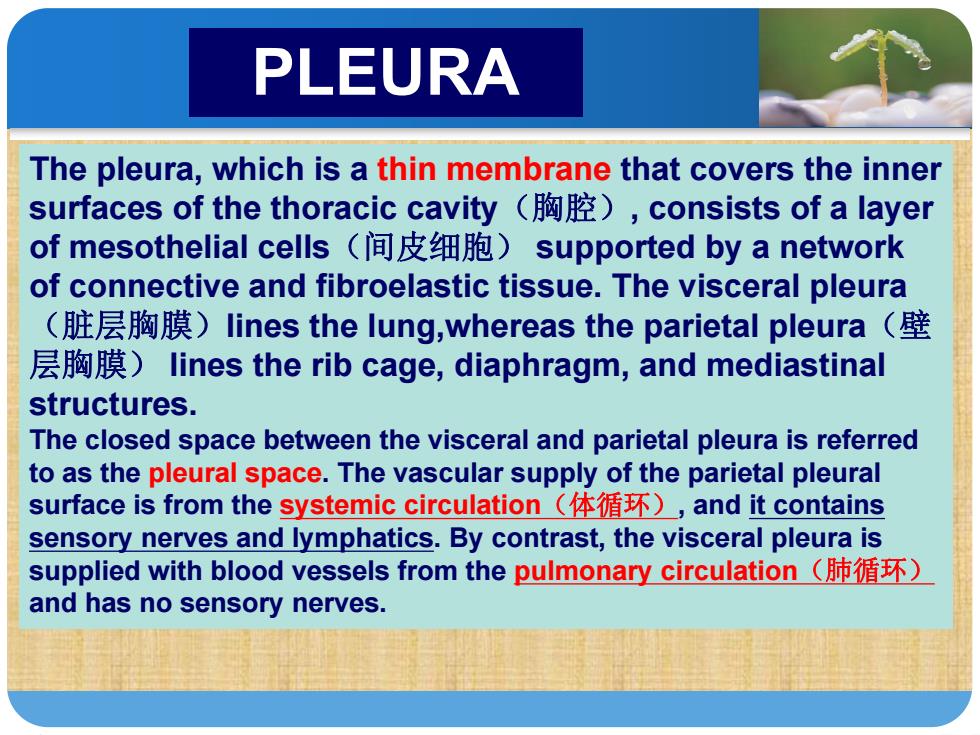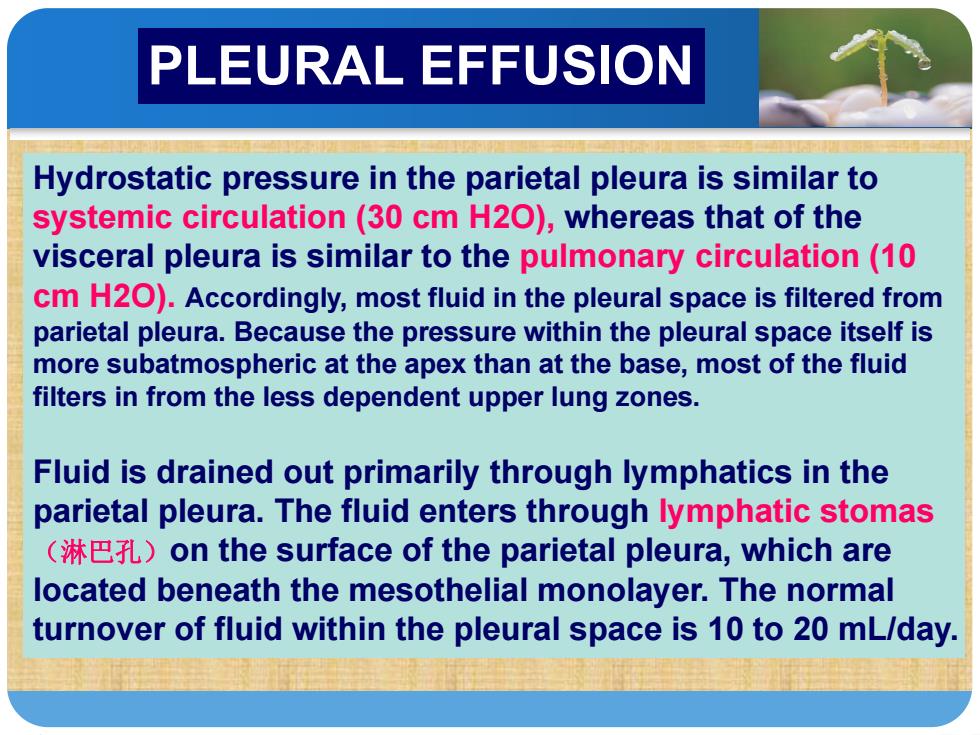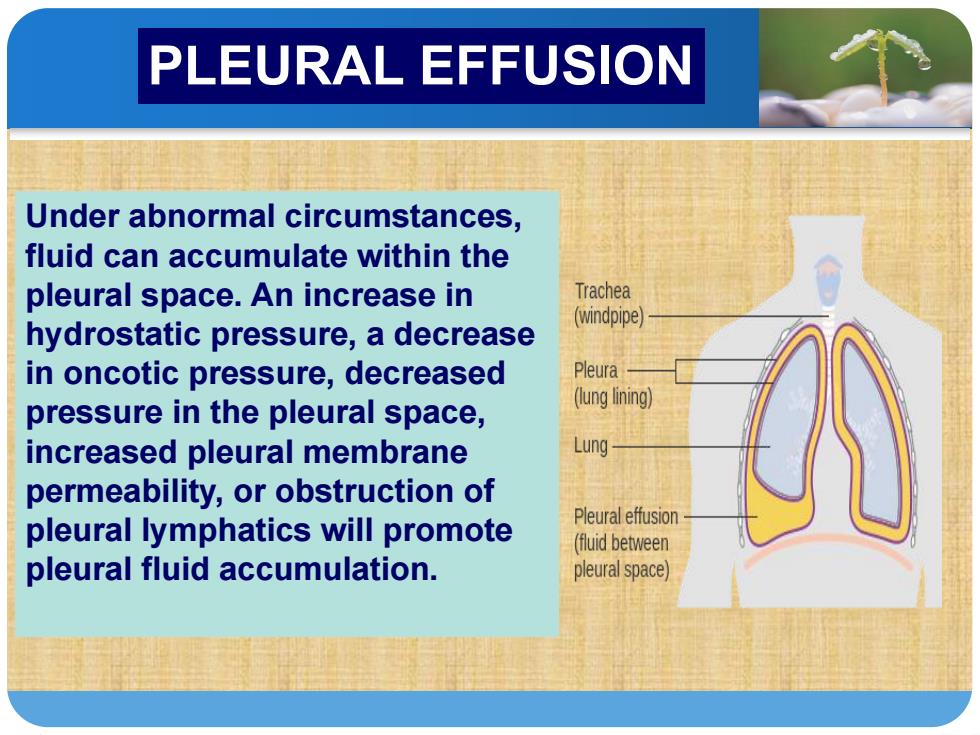
DISEASES OF PLEURA Pleural effusion 南方医科大学江医院 胸腔积液 呼吸科 pneumothorax 夏虎 气胸
Pleural effusion 胸腔积液 pneumothorax 气胸 南方医科大学江医院 呼吸科 夏虎 DISEASES OF PLEURA

PLEURA The pleura,which is a thin membrane that covers the inner surfaces of the thoracic cavity(胸腔),consists of a layer of mesothelial cells(间皮细胞)supported by a network of connective and fibroelastic tissue.The visceral pleura (脏层胸膜)lines the lung,.whereas the parietal pleura(壁 层胸膜)lines the rib cage,diaphragm,and mediastinal structures. The closed space between the visceral and parietal pleura is referred to as the pleural space.The vascular supply of the parietal pleural surface is from the systemic circulation(体循环),and it contains sensory nerves and lymphatics.By contrast,the visceral pleura is supplied with blood vessels from the pulmonary circulation(肺循环) and has no sensory nerves
第 一 部 分 The pleura, which is a thin membrane that covers the inner surfaces of the thoracic cavity(胸腔), consists of a layer of mesothelial cells(间皮细胞) supported by a network of connective and fibroelastic tissue. The visceral pleura (脏层胸膜)lines the lung,whereas the parietal pleura(壁 层胸膜) lines the rib cage, diaphragm, and mediastinal structures. The closed space between the visceral and parietal pleura is referred to as the pleural space. The vascular supply of the parietal pleural surface is from the systemic circulation(体循环), and it contains sensory nerves and lymphatics. By contrast, the visceral pleura is supplied with blood vessels from the pulmonary circulation(肺循环) and has no sensory nerves. PLEURA

PLEURAL EFFUSION EPIDEMIOLOGY AND PATHOBIOLOGY Pleural effusions occur most frequently in patients with pneumonia(肺炎)or heart failure(心衰). Normally,a small amount of fluid in the pleural space forms a thin layer between the visceral and parietal pleural surfaces and acts as a lubricant(润滑剂)to minimize friction between the chest wall and lung as they move against each other during inspiration (and expiration (呼气). This flux of fluid depends on the oncotic pressure(渗透压) and hydrostatic pressure(静水压)_within the parietal and visceral pleura as well as the pressure within the pleural space itself
PLE第URA一L E部FF分USION EPIDEMIOLOGY AND PATHOBIOLOGY Pleural effusions occur most frequently in patients with pneumonia(肺炎) or heart failure(心衰). Normally, a small amount of fluid in the pleural space forms a thin layer between the visceral and parietal pleural surfaces and acts as a lubricant(润滑剂) to minimize friction between the chest wall and lung as they move against each other during inspiration(吸气) and expiration (呼气). This flux of fluid depends on the oncotic pressure (渗透压) and hydrostatic pressure (静水压) within the parietal and visceral pleura as well as the pressure within the pleural space itself

PLEURAL EFFUSION Hydrostatic pressure in the parietal pleura is similar to systemic circulation(30 cm H20),whereas that of the visceral pleura is similar to the pulmonary circulation(10 cm H20).Accordingly,most fluid in the pleural space is filtered from parietal pleura.Because the pressure within the pleural space itself is more subatmospheric at the apex than at the base,most of the fluid filters in from the less dependent upper lung zones. Fluid is drained out primarily through lymphatics in the parietal pleura.The fluid enters through lymphatic stomas (淋巴孔)on the surface of the parietal pleura,which are located beneath the mesothelial monolayer.The normal turnover of fluid within the pleural space is 10 to 20 mL/day
第 一 部 分 Hydrostatic pressure in the parietal pleura is similar to systemic circulation (30 cm H2O), whereas that of the visceral pleura is similar to the pulmonary circulation (10 cm H2O). Accordingly, most fluid in the pleural space is filtered from parietal pleura. Because the pressure within the pleural space itself is more subatmospheric at the apex than at the base, most of the fluid filters in from the less dependent upper lung zones. Fluid is drained out primarily through lymphatics in the parietal pleura. The fluid enters through lymphatic stomas (淋巴孔)on the surface of the parietal pleura, which are located beneath the mesothelial monolayer. The normal turnover of fluid within the pleural space is 10 to 20 mL/day. PLEURAL EFFUSION

PLEURAL EFFUSION Under abnormal circumstances, fluid can accumulate within the pleural space.An increase in Trachea (windpipe) hydrostatic pressure,a decrease in oncotic pressure,decreased Pleura (lung lining) pressure in the pleural space, increased pleural membrane Lung permeability,or obstruction of pleural lymphatics will promote Pleural effusion (fluid between pleural fluid accumulation. pleural space)
第 一 部 分 Under abnormal circumstances, fluid can accumulate within the pleural space. An increase in hydrostatic pressure, a decrease in oncotic pressure, decreased pressure in the pleural space, increased pleural membrane permeability, or obstruction of pleural lymphatics will promote pleural fluid accumulation. PLEURAL EFFUSION